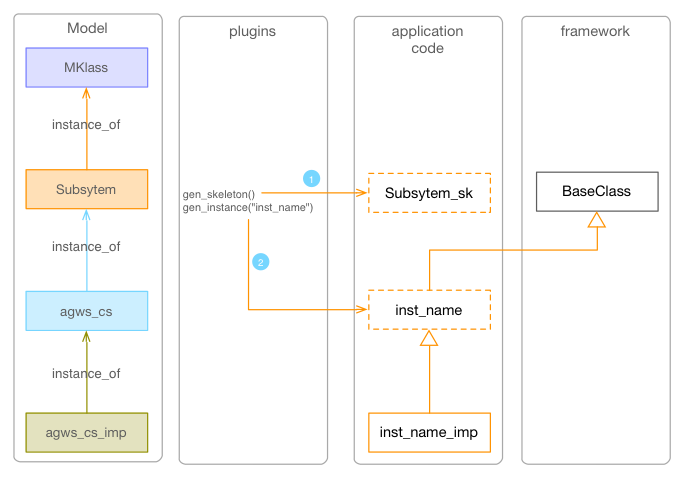7.2. Framework Usage / Code Generation#
GMT frameworks are intended to be extensible by specializing a set of base classes. A set of tools provides the capability to generate the skeleton of a component implementation from the specification of its interface. The Figure below (Component Skeleton Generation) shows the relation between generated skeletons and the GMT modeling framework.
The skeleton generation tools are available for every layer of the modeling framework, i.e. they can generate the skeleton of a model element from the metamodel or generate the skeleton of a runtime component from the model specification.

Fig. 7.1 Component Skeleton Generation. The GMT modeling framework is based in the OMG Meta Object Facility specification. The group on the left shows the main entities in the layered modeling architecture. A set of modular plugins allows one to generate skeletons and instances from layer to layer. The gen_skeleton function (1) allows the generation of the skeleton of a model element. The gen_instance function (2) allows the capability to generate the skeleton of an instance of a model element. Instances are created in the next model layer and they inherit the behavior of some of the framework base classes.#
The table below describes three common framework use cases and the functionality provided by the frameworks involved.
Use Case |
Framework |
Base Classes |
Function |
|---|---|---|---|
Create a new Controller |
Core Framework |
Base Component |
Provides access to observatory services |
Device Control Framework |
BaseDeviceController |
Provides usable control building blocks |
|
I/O Framework |
IOModule, Device |
Provides access to the hardware |
|
Create a new Pipeline |
Core Framework |
BaseComponent |
Provides access to the observatory services |
Data Processing Framework |
Pipeline, Filter, Recipe |
Defines a reference architecture for data processing pipelines |
|
Persistence Framework |
ObjectStore, FileStore |
Provides persistence to files and data structures |
|
Create a new Panel |
Core Framework |
BaseComponent |
Provides access to Observatory Services |
UI Framework |
Panel, Widget |
Provides reusable visualization components |